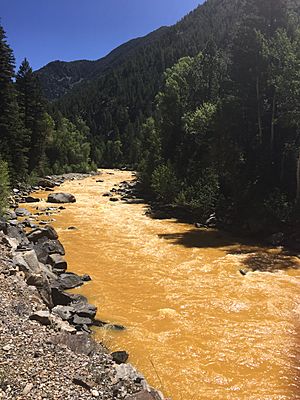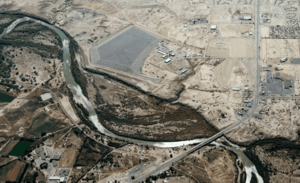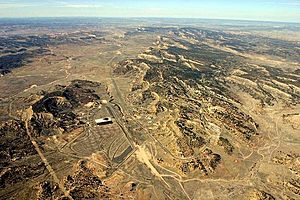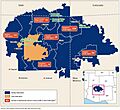Uranium mining and the Navajo people facts for kids
In the 1950s, many people from the Navajo Nation found jobs in uranium mines. At that time, people did not know about the dangers of lung cancer from uranium mining. Also, the Navajo language did not have a word for radiation. This meant miners did not know about the health risks. Water is very important to the Navajo people. The damage to their land and livestock from mining has made it hard for them to practice their culture.
The Navajo Nation faced the biggest radioactive accident in U.S. history during the Church Rock uranium mill spill in 1979. A pond holding radioactive waste broke. This sent dangerous waste into the Puerco River. It harmed people and killed animals.
Today, about 30% of people in the Navajo Nation do not have running water. They are 67 times more likely to live without running water than other Americans. Often, they must use unregulated water sources. These sources can have bacteria, animal waste, and uranium. A lot of uranium mining happened in the mid-1900s. Now, this mining causes problems with water pollution. It also causes lasting health issues from being exposed to uranium.
Water in the Navajo Nation has about 90 micrograms of uranium per liter on average. Some areas have over 700 micrograms per liter. The Environmental Protection Agency (EPA) says 30 micrograms per liter is a safe amount. Drinking uranium can cause kidney damage and failure. This is because kidneys cannot filter uranium out of the blood. The rate of End Stage Renal Disease in the Navajo Nation is 0.63%. This is much higher than the national average of 0.19%.
The U.S. Environmental Protection Agency (EPA) has been cleaning up uranium mines on the Navajo Nation since 1994. This is part of a program called Superfund. The Abandoned Mine Land program and Contaminated Structures Program help clean mines. They also tear down buildings made with radioactive materials. However, some Navajo people and journalists say the EPA's efforts are unfair and not effective.
In October 2021, a group called Eastern Navajo Diné Against Uranium Mining took a case to the Inter-American Commission on Human Rights. They said the U.S. government violated the human rights of Navajo Nation members.
Contents
How Uranium Mining Started
Uranium mining began on Navajo Nation lands in 1944. This was for the U.S. military's Manhattan Project. After 1946, the United States Atomic Energy Commission took over. Then, a lot more uranium mining started on Navajo lands. This was part of a nuclear arms race with the Soviet Union during the Cold War.
Large amounts of uranium were found in the Southwest. Many mines were built on and near the Navajo Reservation. Before the EPA was created in 1970, there were not many rules for protecting the environment. This mining put thousands of Navajo workers in danger. It also caused pollution that still affects the air, water, and land today.
Private companies hired many Navajo men to work in the mines. These companies and the United States Atomic Energy Commission knew about the health risks. But they did not tell the Navajo workers about the dangers. They also did not make rules to keep pollution low. Even as they learned more, they were slow to help the workers.
In 1951, the United States Public Health Service started a study on Navajo miners. They did this without asking the miners if it was okay. They wanted to see the long-term health effects of radiation. This study showed high rates of cancers and other illnesses. These problems came from uranium mining and processing. For many years, companies and the government did not make things safer. Workers often had trouble getting paid for their illnesses. In 1990, the U.S. Congress passed the Radiation Exposure Compensation Act. This law was meant to help people affected by uranium poisoning. But some Navajo people say the rules make it hard to get help.
Since 1988, the Navajo Nation has had a program to clean up old mines. But many problems from uranium mining still exist today. More than a thousand old mines have not been cleaned up. These mines still pose health risks to Navajo communities. The EPA thinks there are 4,000 mines that produced uranium. There are also 15,000 other places with uranium in 14 western states. Most are in the Four Corners area.
In 2005, Navajo Nation President Joe Shirley Jr. signed a law. This law, called the Diné Natural Resources Protection Act, stopped uranium mining on Navajo Nation lands.
The Church Rock Uranium Spill
On July 16, 1979, a pond at a uranium mill in Church Rock, New Mexico, broke. Over 1,000 tons of radioactive waste and 93 million gallons of acidic, radioactive water flowed into the Puerco River. The pollution traveled 80 miles (129 km) downstream. It affected sewers, water sources, and left contaminated pools.
This spill released more radioactivity than the Three Mile Island accident that happened earlier that year. It is known as the largest radioactive accident in U.S. history.
The state's plan to warn people was only in English. Most people affected were Navajo and did not learn about the danger right away. Local people used the river for fun and gathering plants. Residents who walked in the acidic water went to the hospital with burning feet. They were wrongly told they had heat stroke. Many sheep and cattle died. The Navajo Nation asked New Mexico's governor for help. They wanted the area to be declared a disaster zone. But the governor said no. This limited the help the Navajo Nation received.
For almost two years, the government brought water to the reservation by truck. But this program ended in 1981. Farmers had to start using the river again for their animals and crops.
Cleaning Up Abandoned Mines
The Navajo Nation Abandoned Mine Land(s) (NN AML) program deals with many old mining sites. These sites are on Navajo lands and were used for uranium mining. Some important sites include:
- Abandoned Uranium Mines on the Navajo Nation, Arizona. This area has many of the "521 abandoned uranium mine areas."
- Skyline Abandoned Uranium Mine, Utah. This is in Monument Valley.
- Northeast Church Rock Mine, New Mexico. This is a very important cleanup site.
The EPA works with the Navajo Nation. Since 1994, the Superfund Program has helped find contaminated sites. It also helps with cleanup. The EPA has made agreements worth over $1.7 billion. These agreements help reduce radiation risks to the Navajo people. As a result, money is available to check and clean up 219 of the 523 abandoned uranium mines.
Uranium mining happened on the Navajo Nation from 1944 to 1986. Some local people used materials from these mines to build their homes. These materials, like ore and waste rock, could have been used for foundations, walls, or fireplaces. This can lead to people being exposed to radiation.
The EPA and the Navajo Nation Environmental Protection Agency (NNEPA) have a program called the Contaminated Structures Program. This program checks buildings on the Navajo Nation. It looks for homes built with old mine materials or near abandoned mines. The program removes and cleans up contaminated buildings and materials if they are a risk. This program is free for Navajo residents. The EPA and NNEPA have checked over 1,100 buildings since 2007.
How the Cleanup Program Started
The Abandoned Uranium Mines on the Navajo Nation became a Superfund site in 1994. This happened after a meeting in Congress in 1993. The Superfund program helps the U.S. government pay for cleaning up dangerous waste sites. The Navajo Nation is in the EPA's Region 9. This region covers Arizona, California, Hawaii, Nevada, and Tribal Nations. The Church Rock Mine is one of the EPA's most successful cleanup sites.
In 1997, the EPA started using helicopters to survey the mines. They measured radiation from abandoned uranium mining areas. The goal was to see if these sites were dangerous to people.
In 2008, the EPA announced a five-year plan for cleanup. This plan had nine goals for 2008-2012. These included checking contaminated buildings and water sources. They also planned to clean up high-priority mines like Church Rock Mine. The EPA has released reports each year about their progress. By 2011, they had checked many buildings and water sources. They also provided clean drinking water to hundreds of homes.
The EPA says the Abandoned Uranium Mine Superfund site is not on the National Priorities List (NPL). This list is for the most dangerous sites needing long-term cleanup. The EPA says it's "not likely" for these mines to be on the NPL. This has led to some criticism. There are over 500 uranium sites, but only a few have full cleanup plans.
Who Helps with Cleanup?
Many groups work with Superfund to clean up mining sites. These include:
- Navajo Nation Environmental Protection Agency (NNEPA)
- Indian Health Services (IHS)
- Diné Network for Environmental Health (DiNEH)
- Navajo Nation Department of Water Resources (NNDWR)
- Department of Energy (DOE)
- US Nuclear Regulatory Commission (NRC)
The NNEPA helps the EPA decide which buildings to tear down and which water sources are dangerous. They also work together to teach Navajo people about safety. The Centers for Disease Control and Prevention and the DiNEH Project also help with water quality and community outreach. The Navajo Nation Department of Water Resources helps bring water to residents near contaminated sources. Indian Health Services helped pay for a large drinking water project.
Concerns and News
The EPA says it has a "strong partnership" with the Navajo Nation. But some recent articles question how fair and effective the EPA's work is. In 2012, The New York Times published an article. It suggested that politics and money affect which mines get cleaned up first. Some say that questions about whether pollution is from old mining or natural uranium slow down the cleanup.
The EPA does prioritize mines closest to homes. But some remote areas where people live have been overlooked. For example, in Cameron, Arizona, a rancher found an abandoned uranium mine in 2010. There were no warning signs for people in the town. A news article suggested that the EPA only checked the site faster because of public attention.
Similar claims were made about the Skyline Mine. A Navajo woman's story in the Los Angeles Times led to more attention on that site. An EPA worker even said this publicity "might have bumped the site up the priority list."
Even after the rancher found the mine in Cameron, the EPA did not make it a priority. When reporters asked EPA officials to visit the Cameron site, they refused. They offered to visit a newly cleaned site instead. A Navajo hotel manager near the Skyline Mine was unsure about the EPA's cleanup. He said, "That's what they want you to see: something that's all nice and cleaned up." People are concerned that cows graze on contaminated land and then people eat the meat. While beef is tested, standard tests do not check for radioactive substances like uranium.
There are also concerns about a plan to start uranium mining near Church Rock again. An online petition has gathered many signatures against this new mining.
Cleanup Efforts
Since 1994, the EPA and the Navajo Nation Environmental Protection Agency have been mapping radioactive areas. In 2007, they made a map of old uranium mills to help remove nuclear waste. In 2008, the EPA started a five-year cleanup plan. This plan focused on contaminated water and buildings. The EPA believes that 30% of Navajo people do not have clean drinking water.
The EPA is working on 500 abandoned uranium mills as part of their plan. Their goal is to remove nuclear waste from the area. They first focused on finding contaminated water and buildings. Many contaminated buildings have been torn down. In 2011, they finished a project to remove 20,000 cubic yards of contaminated dirt from near the Skyline Mine.
In 2017, a $600 million agreement was made to clean up 94 abandoned uranium mines.
The EPA and NNEPA chose 46 mines as top priorities. They picked these based on radiation levels, how close they were to homes, and if they could pollute water. Detailed cleanup checks will happen at these mines.
The federal government is looking for businesses to help clean up abandoned uranium mines. There is $220 million available for small businesses. This money comes from a $1.7 billion agreement with Tronox, a company that used to mine in the area. During the Cold War, companies took almost 30 million tons of uranium from Navajo land. The EPA says it has money to check and clean up 220 of the 520 abandoned mines.
People living in the Red Water Pond Road area have asked to move to a new village. This would be while the cleanup of the Northeast Church Rock Mine Superfund site happens. This is an alternative to moving to Gallup, which the EPA suggested.
Images for kids





